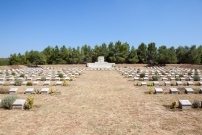| First Name: | Frederick William | Last Name: | GOULD | |
|---|---|---|---|---|
| Date of Death: | 15/08/1915 | Lived/Born In: | Plaistow | |
| Rank: | Private | Unit: | Essex6 | |
| Memorial Site: | West Ham Tramway Memorial, Greengate Street, Plaistow | |||
Current Information:Age-26 Enlisted-West Ham Hill 10 Cemetery, Suvla, Gallipoli
Gallipoli 1915 On 25 April, British, Australian and New Zealand forces landed on the Gallipoli peninsula. The plan was that these forces would soon defeat a demoralised Turkish army, knock Turkey out of the war, open up the Mediterranean to the Russian navy and threaten Austro-Hungary from the south. None of these things were achieved despite nine months of hard fighting in terrible conditions. It was a heroic failure. By July, 1915, and after much fierce fighting, stalemate had set in at Gallipoli both at Cape Helles where the British and French had landed and at Anzac Cove where the Australian and New Zealand Corps were unable to break out of their beach head. Fresh troops were needed and they were on their way in the shape of four divisions from Britain and things were put on hold until they arrived. The plan for August was for a landing at Suvla Bay to the north of Anzac Cove whilst at the same time, the ANZAC Corps, reinforced by some of the new British troops would effect a breakout from Anzac Cove and establish a line across the peninsula. Whilst this was going on the troops in the south at Helles would stage a number of diversionary attacks. But it all went horribly wrong and much of the reason for this can be explained by inadequate planning and leadership. Nobody seemed to know what they were supposed to be doing and Lieutenant-General Stopford, in charge of the Suvla landings was particularly out of his depth. The landings at Suvla failed to link up with the forces at Anzac and the breakout from there did not happen despite valiant efforts by all concerned. The loss of life on all fronts was again enormous. L.A. Carlyon’s excellent book “Gallipoli” gives a superb yet chilling account of the events. The 54th Division was the last to arrive at Gallipoli, landing at Suvla Bay from 10th to15th August, 1915. The 6th Essex battalion of 161 Brigade came ashore at A Beach on 11th August and on the next day moved forward to reserve positions. On 13th August the battalion took part in a brigade attack on Kiretch Tepe Sirt, the ridge of hill stretching along the northern side of Suvla Bay, but after making some progress they were forced to retire in the face of heavy shrapnel and rifle fire. On 14th August they advanced once again and relieved the 8th Hampshire battalion in the firing line, suffering more casualties as they did so and on the following day moved to the support line behind Jephson’s Post, before taking over the front line there on 16th August. 6th Essex suffered a number of casualties from shrapnel, machine gun and rifle fire during this period of heavy fighting, one of whom was Frederick Gould who died from wounds on 15th August. |
||||
| « Back to Search Results | ||||
| If you think any of the information shown here is incorrect, Click Here to submit your amends and comments | ||||




